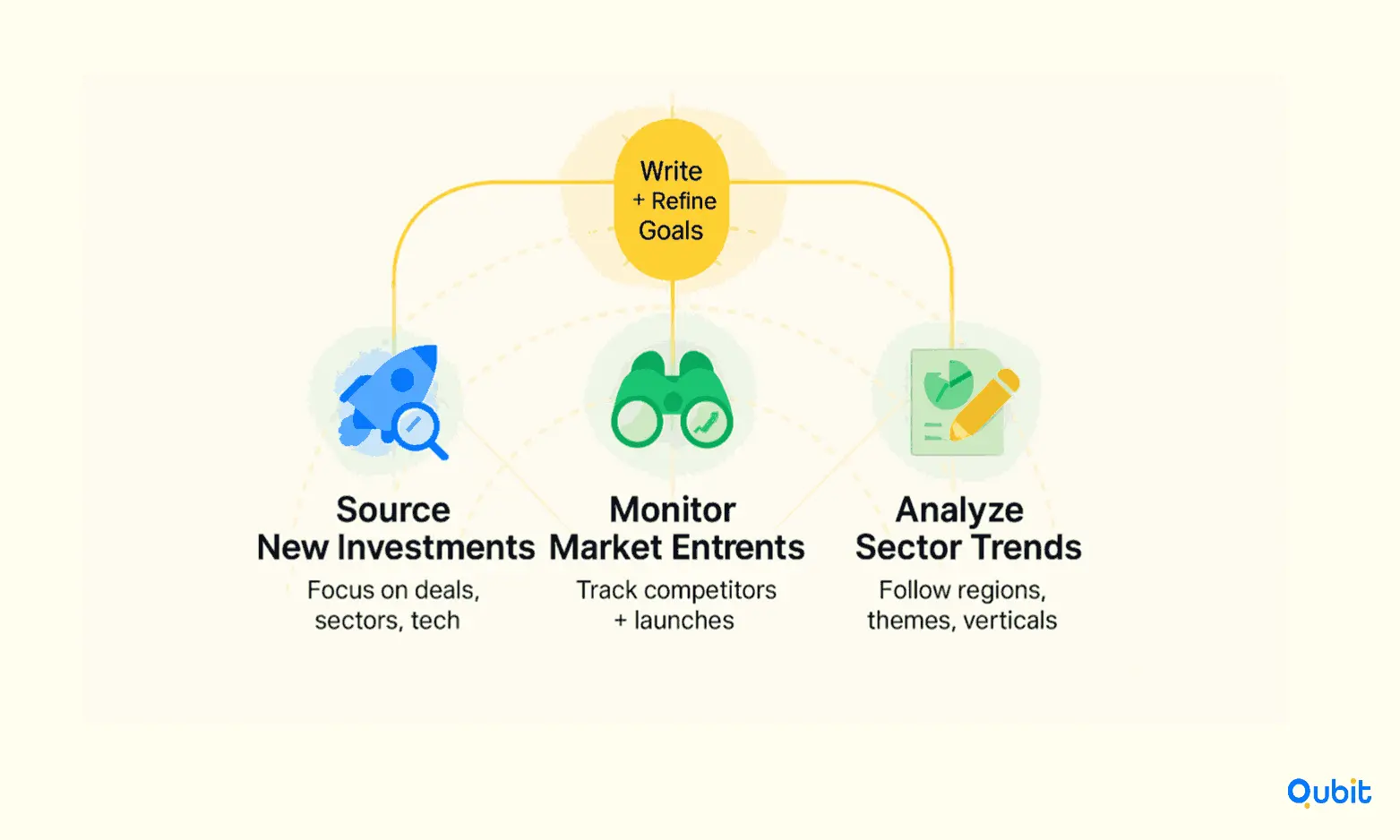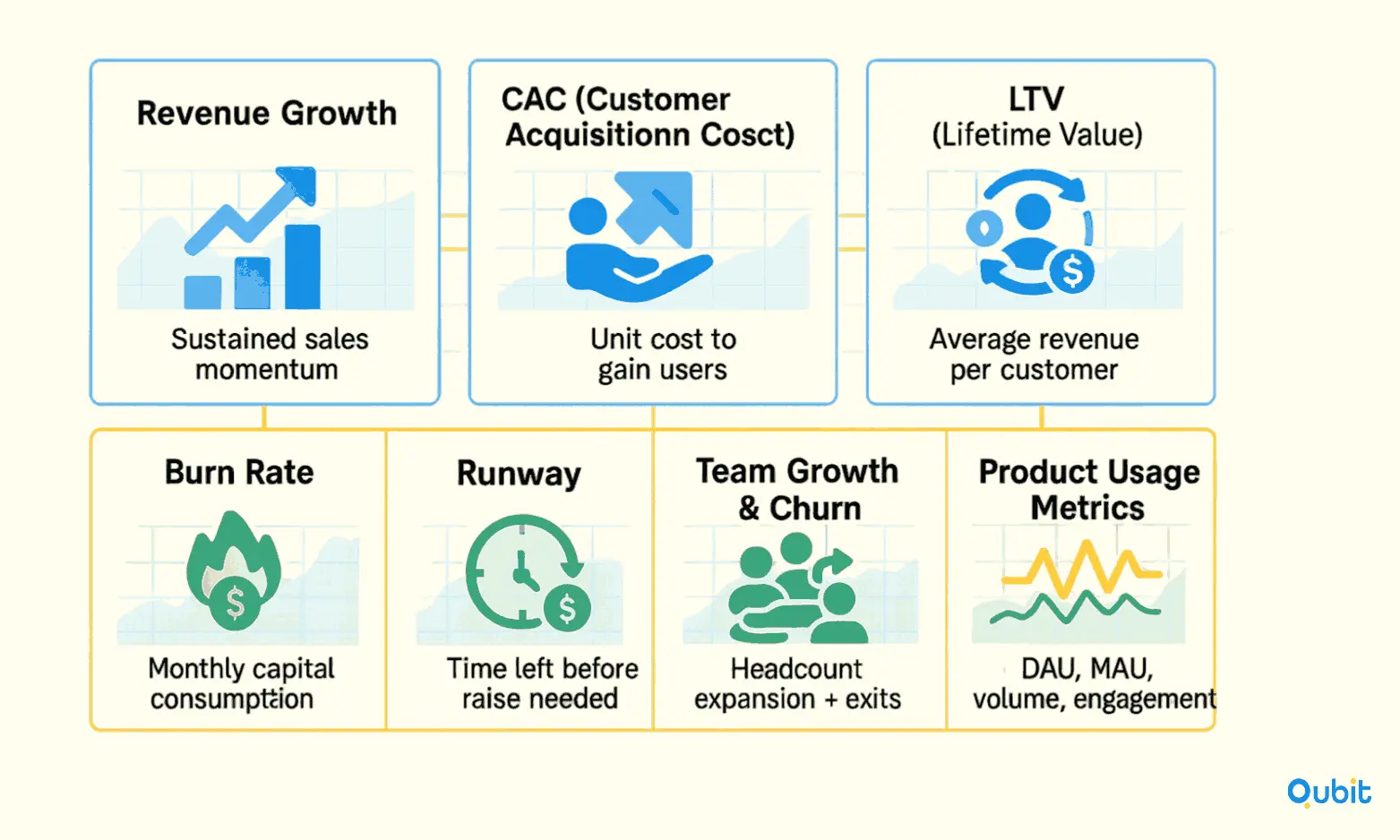Staying informed about startup funding news and investor signals is crucial for entrepreneurs and investors alike. However, the sheer volume of information available can quickly become overwhelming. From announcements about funded startups to emerging trends in venture capital, the challenge lies in filtering out the noise to focus on actionable insights.
This guide serves founders, investors, and analysts seeking streamlined startup research. It will guide you through effective strategies to streamline your research process, ensuring you stay ahead without wasting time on irrelevant data.
Understanding Your Objectives for Tracking Startup Funding News
Before diving into tracking tools and workflows, the critical first step is to clearly define why you want to track startup funding news and investor signals.
Specialized databases (platforms providing structured funding data like Crunchbase) and curated newsletters (hand-picked funding news emails) help you track startups efficiently. Organize your workflows to capture actionable and relevant updates.

Checklist: Setting Your Tracking Objective
- Are you seeking new investment opportunities? If your goal is to identify promising startups to fund, your research will emphasize deal stages, sectors with growth potential, and emerging technologies.
- Are you monitoring competitors or market entrants? Entrepreneurs and corporate scouts often track funding activity to anticipate new products, partnerships, or disruptive entrants.
- Are you interested in sector-wide or regional trends? Analysts and consultants may focus on macro trends such as AI investment surges or geographic hotspots like Southeast Asia or Central and Eastern Europe (CEE).
Grounding your objectives in real numbers sharpens research focus. For instance, Series A rounds exceed $10 million in most industries, while seed rounds typically span $10,000 to $3 million. Knowing these thresholds clarifies realistic target selection, preventing misaligned expectations.
Assessing your objectives helps you narrow the universe of startups and news, tailor your use of tools and networks, and sharpen your workflows to maximize efficiency and clarity. For a deeper dive into market research techniques, explore how startup scouting strategies can help connect advanced investment analysis with broader startup evaluation practices.
Equally important is writing down these goals and refining them periodically. For example, an early-stage investor may initially track seed and Series A rounds in FinTech but later adjust focus toward Series B or later rounds in renewable energy as strategies evolve.
Specialized Tools for Tracking Startup Funding News
Equipping yourself with the right tools is fundamental to tracking startup funding news and investor signals efficiently.
Using Predictive Intelligence Platforms for Early Startup Discovery
Building on these foundational tools, predictive intelligence platforms offer a proactive approach to identifying high-potential startups before they become widely recognized. These platforms analyze millions of data points, including funding momentum, team growth, and market signals, to forecast emerging leaders. Integrating predictive analytics into your workflow enables investors and founders to maintain a competitive pipeline and act on opportunities ahead of broader market awareness.
AI startups accounted for a record-breaking $110 billion in funding in 2024. This rapid influx illustrates how AI drives capital reallocation, influencing signals captured by top monitoring platforms. Prioritizing sector analysis ensures stakeholders spot emerging opportunities.
Fundraising platforms now capture immense flows. On Carta, startups raised $79.8B by Q3 2025 alone, illustrating the surge in capital accessible to growing companies. Here are some other platforms like Carta which you can utilize to build up a foundation for discovering early startup news:
- CB Insights: Renowned for comprehensive corporate and startup data, CB Insights captures real-time funding events, valuations, investor profiles, and sector trends. Its detailed market maps and predictive analytics help identify emerging sectors and hot startups.
- PitchBook: A staple among private market data providers, PitchBook offers deep dives into deal activity, valuations, investment stages, and investor syndicates. Their periodic venture monitors provide quarterly snapshots on capital flows and emerging ecosystems.
- Crunchbase: While offering both free and subscription tiers, Crunchbase boasts a vast database crowd-sourced by startups and investors themselves. It’s excellent for initial discovery and monitoring early-stage companies’ funding announcements.
- AngelList: Focused heavily on seed and early-stage startups, AngelList offers both investment opportunities and startup profiles, often including direct founder interactions.
The key to maximizing these tools is to leverage their filtering capabilities smartly. For example, you might set alerts for startups in AI with recent seed funding in North America or track mega-rounds above $100 million globally.
In addition to these platforms, specialized industry newsletters and curated content aggregators provide complementary perspectives on market dynamics. To enhance your research, consider integrating insights from data platforms for startup scouting, which demonstrate how leveraging technology can refine your investment research process.
Curated Newsletters, Regional Reports, and Segmentation
Regional reports reveal explosive expansion. In India, startup creation soared from 20,000 in 2015 to over 159,000 by early 2025. This surge underscores the need to monitor localized trends closely.
In venture capital, timing and depth of insight are crucial. While databases provide raw data, curated newsletters distill key funding news into concise, thematic snapshots aligned with emerging trends. Subscribing to relevant publications ensures that you receive focused intelligence regularly:
- Sector-focused newsletters: For instance, reports dedicated to Artificial Intelligence, FinTech, or HealthTech capture the pulse of funding trends and spotlight high-growth startups.
- Regional reports: Notably, the venture capital scene in Central and Eastern Europe (CEE) has been gaining traction. Quarterly reports like the “VC Funding in CEE Report Q1 2025” reveal localized deal flow, investor interest, and sector hotspots within that geography, helping investors spot opportunities outside traditional hubs like Silicon Valley.
- Thematic reports: Broader analyses, such as the PitchBook-NVCA Venture Monitor or CB Insights’ AI dominance reports, contextualize data within thematic trends like mega-round consolidation and AI’s outsized share of funding.
How to Segment Funding News by Industry
- Identify core industries relevant to your investment or business focus, such as AI, fintech, or healthcare, for efficient tracking.
- Subscribe to newsletters or reports that specialize in these industries to receive timely, filtered updates on funding activity.
- Organize collected news by industry in your workflow to quickly spot trends and prioritize follow-up actions.
Community-Sourced Deal Reporting for Broader Coverage
Building on curated newsletters, community-sourced deal reporting enables broader and faster coverage of funding events. Platforms that invite user submissions capture local deals and emerging trends often missed by traditional media. This approach fosters ecosystem participation and ensures more comprehensive, up-to-date intelligence. For investors and founders, engaging with these communities can surface unique opportunities and provide early signals.
Curated Newsletters vs. Real-Time Databases
Developing Systematic Workflows for Tracking Funded Startups
To turn information into insight, building a systematic tracking workflow is essential. A workflow is a repeatable process that ensures no key data slips through the cracks while prioritizing opportunities that align with your objectives.
Core components of an effective workflow include:
- Categorization by funding stage: Distinguish startups by seed, Series A, B, C, or late-stage rounds. Early-stage rounds indicate emerging ideas, whereas later-stage rounds often signal companies gearing up for market expansion or IPO.
- Deal size segmentation: Mega-rounds are funding rounds exceeding $100 million. These often reflect emerging market leaders and major sector shifts.
- Industry and technology tagging: Use sector metadata to classify startups in AI, biotech, defense tech, etc. This helps isolate areas of keen interest rapidly.
- Regular review cycles: Set periodic cadence (weekly, biweekly) for catching up on new funding events, filtering duplicates, and refreshing insights.
- Flagging strategic cases: Highlight notable case studies such as mega-rounds from key players. For example, a $14 billion Series round by an AI-driven startup illustrates significant market activity.
For those focused on technology-driven startups, a thorough exploration of market trends complements the approach to spot disruptive tech startups early, illustrating how detailed research can highlight emerging technological shifts.
Learning from Case Studies: Exemplars of Market Trends
Case studies offer valuable lessons on investor behavior and market dynamics, insights often lost in aggregate data.
- Scale AI and Meta Mega-Round: The reported $14.3 billion funding from Meta to Scale AI demonstrates a strategic thrust to dominate AI infrastructure development. Such mega-rounds often presage broader ecosystem shifts and indicate transformative potential.
- xAI’s $10 Billion Combined Debt and Equity Raise: Indicative of the growing scale and complexity of AI startups’ financing structures. Combining debt and equity financing reflects maturity and confidence from investors in breakthrough technologies.
- Anduril’s Follow-On Round in Defense Tech: Raising $2.5 billion at a $30.5 billion valuation, Anduril spotlights a niche yet critical sector, defense technology, which is attracting substantial private investment amid geopolitical tensions.
- Thinking Machines Lab’s $2 Billion Seed Round: This staggering seed funding round underscores how data-centric companies are commanding unprecedented early-stage capital, reflecting AI and data science’s centrality to future innovation.
Digital Discovery & Networking for Funded Startups
Discovering promising startups before they reach the public spotlight requires a blend of digital tools and off-platform strategies.
Digital Platforms
- Centralized hubs like Crunchbase, AngelList, and PitchBook allow filtering startups by industry, geography, and funding stage, facilitating preliminary discovery.
- Subscription-based analytics tools add market trend analyses, competitive landscapes, and detailed deal data, useful for deeper vetting.
Using Verified Contact Databases for Efficient Post-Funding Outreach
Extending your digital discovery, verified contact databases enable targeted outreach to startups during their critical post-funding growth phase. These resources provide double-verified emails and contact details, reducing bounce rates and improving engagement. Initiating outreach within three to six months after funding maximizes the likelihood of connecting with decision-makers as they scale operations.
Multi-Channel Approaches
- Personal networks: Relationships with founders, accelerators, and venture capitalists offer early intel unavailable on public platforms.
- Industry events: Conferences like TechCrunch Disrupt and Web Summit provide face-to-face insights and an opportunity to evaluate founders and pitches firsthand.
- Online communities: Engaging on LinkedIn, Twitter, and sector-specific forums helps uncover emerging startups and trends dynamically.
Integrating these approaches enriches your discovery pipeline and increases the chances of identifying high-potential startups before others.
Building Effective KPI Dashboards to Monitor Startup Performance
Tracking startup funding news and investor signals is critical. Ongoing monitoring helps investors make informed decisions and anticipate market shifts. Dashboards help visualize momentum. In 2023, 5.5 million businesses were started, up from five million in 2022. Tracking this uptick positions stakeholders to identify high-growth opportunities early.
A KPI dashboard is a tool showing key metrics like revenue, CAC, and growth to help investors monitor startup performance. Here is how you can track the growth using different metrics:

Key Elements to Include in Your KPI Dashboard:
- Revenue Growth: The pace at which a startup increases its sales reflects market traction and scalability potential. Look for sustained and accelerating growth patterns.
- Customer Acquisition Cost (CAC): How much it costs to acquire new customers gives insight into marketing efficiency and unit economics.
Unit economics (financials for each customer or sale) show if growth is sustainable.
- Lifetime Value (LTV): The average revenue a customer brings during their relationship with the startup indicates profitability potential relative to CAC.
- Burn Rate: The monthly cash outflow rate helps assess how quickly a startup is consuming capital and its runway.
- Runway: The time a startup can operate before needing more capital, derived from cash reserves and burn rate.
- Employee Growth & Churn: Headcount expansion and turnover can signal operational health or instability.
- Product Metrics: Depending on the startup’s nature, metrics like daily active users (DAU), monthly active users (MAU), user engagement times, or transaction volumes can be valuable.
Tools for Building Dashboards:
- Tableau and Power BI: Robust business intelligence tools that support advanced data modeling and interactive visualizations.
- Google Data Studio: A free and user-friendly option to integrate multiple data sources and create shareable dashboards.
Avoiding Data Pitfalls: Verification and Quality Control
In an ecosystem where rumors, inflated valuations, and incomplete information abound, data verification is crucial.
Rigorous verification is vital as 90% of startups experience failure. High attrition rates underscore the importance of vetting news, especially for early-stage ventures. For investors, credible data separates high-risk speculation from actionable signal.
Best Practices include:
- Cross-Checking Information: Validate funding news across multiple sources, such as press releases, regulatory filings, trusted databases, and direct company communications.
- Understanding Data Lag: Recognize that some platforms update with a delay; flagged news items may precede database entries.
- Assessing Source Credibility: Prioritize data from verified or primary sources over third-party reports or social media speculation.
- Monitoring Data Freshness: Regularly audit your data sources for updates or corrections.
- Beware of Exaggerated Claims: Unusually large seed rounds or mega-rounds should be approached skeptically and confirmed with official announcements or investor disclosures.
Watch for duplicated news, misspelled startup names, and regional reporting gaps in your workflow. For example, a funding round may appear in one source but not another, flag these discrepancies and seek confirmation before acting. Implementing these checks safeguards your workflow from misinformation and poor decision-making.
Conclusion
Staying ahead in the competitive startup ecosystem requires a proactive approach to track startup funding news and investor signals. By utilizing real-time data and curated resources, businesses can make informed decisions that align with their growth objectives. The strategies outlined in this article emphasize the importance of integrating reliable tools and insights to identify opportunities effectively.
We encourage you to implement these methods and explore the tools discussed to refine your investor discovery process. If you're seeking precise investor leads, we at Qubit Capital can help with our Investor Discovery and Mapping service. Let’s start mapping out success together.
Key Takeaways
- Streamlined tracking methods reduce information overload and enhance decision-making.
- Digital tools and curated resources are essential to monitor funding news efficiently.
- Recent data, including mega-rounds and shifting investor behavior, underscore market trends.
- Systematic workflows and case studies offer actionable insights for investors.
- Qubit Capital's tailored services empower you to engage effectively in the investment landscape.
Frequently asked Questions
How can I filter startup funding news by sector?
Use tools like Crunchbase or PitchBook to filter startup funding news by sector. This helps you focus on industries like AI, fintech, or healthtech efficiently.






